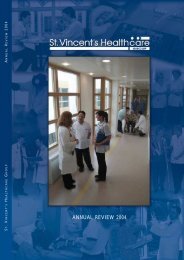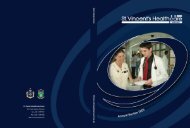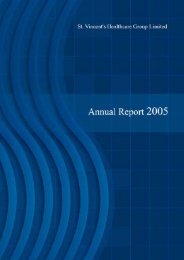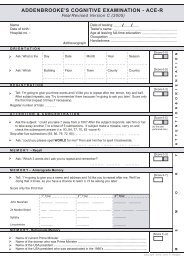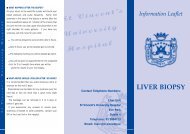ANNUAL REVIEW master Final3a - St Vincent's University Hospital
ANNUAL REVIEW master Final3a - St Vincent's University Hospital
ANNUAL REVIEW master Final3a - St Vincent's University Hospital
Create successful ePaper yourself
Turn your PDF publications into a flip-book with our unique Google optimized e-Paper software.
<strong>St</strong>. Vincent’s Healthcare Group Limited - Annual Review 2007<br />
Education & Research<br />
effects on cell proliferation, MMP2/9 production and tubule formation. Furthermore Wei has demonstrated<br />
that VEGF +Ang2 synergistically induces NOTCH 1IC, 3IC and 4IC signalling pathways. Currently we are<br />
using an RA human synovial /SCID mouse model (in collaboration with Prof. Costantino Pitzalis, London) to<br />
examine the effect of blocking either the NOTCH signalling pathway or the Tie-2 receptor on blood vessel<br />
regression Wei was awarded Seed funding through the UCD scheme to travel to the American College of<br />
Rheumatology Boston to present his work.<br />
Fig 3: (above) Dual immunoflourescent staining with<br />
Factor VIII (red) and ·SMA (GREEN). Blood vessel<br />
staining red are immature and those staining for red and<br />
green are mature. This figure shows there is a mixture<br />
of immature and mature vessels in the joint.<br />
(iv) GMCSF and TLRs<br />
Dr. Sinead Nic An Ultaigh has been examining the role of Granulocyte-Macrophage Colony <strong>St</strong>imulating<br />
Factor (GM-CSF) as part of our continuing work on cytokine networks in inflammatory arthritis. GM-CSF is<br />
found at higher levels locally in the joints of patients with inflammatory arthritis, while levels in serum were<br />
practically undetectable. Anti-GM-CSF may inhibit pro-inflammatory cytokines in our ex-vivo explant model<br />
from patients with inflammatory arthritis. Preliminary data also indicates that GM-CSF receptor alpha is<br />
expressed in the lining layer of the synovial tissue and in the endothelial cells of blood vessels of arthritis<br />
patients. Sinead is also examining the role of Toll-Like Receptors (TLRs) in inflammatory arthritis. TLRs have<br />
been implicated in autoimmune diseases, and TLR expression has been found in joint tissue and at the sites<br />
of invasion into cartilage/bone of patients with RA and PsA. Sinead has shown that cytokines and<br />
chemokines are increased in PBMCs, primary fibroblasts and novel ex-vivo synovial explants from patients<br />
with inflammatory arthritis when stimulated with TLR 2 and 4 agonists. Prelimiary data has also<br />
demonstrated induction of NOTCH 1 in synovial fibroblasts in response to TLR-2 and TL-4 stimulation.<br />
Future work will focus on the interaction of Notch and NFκB in response to TLR signalling.<br />
(v) Proof of Concept <strong>St</strong>udies<br />
Jennifer Mc Cormick is an integral part of the team and is involved in a number of projects in the group. In<br />
particular Jenny works on the signalling pathways and matrix invasion using zymography with Mary, Aisling<br />
and Ellen. She processes the tissue, cells, serums/ synovial fluids from all of the arthroscopies which are<br />
vital to all of the research carried out in the group. We have developed a number of partnerships with the<br />
drug discovery and translational teams within industry led by Prof Veale. Jenny, Ursula and Sinead carry out<br />
these studies using synovial explant cultures, MSD multiplex assays and transcriptomics to establish preclinical<br />
and ‘proof of concept’ drug development studies of novel bio therapeutics and small molecular weight<br />
candidates.<br />
(2) Remission study and Rituximab therapy for resistant arthritis<br />
Withdrawal of anti-TNFα therapy in patients with rheumatoid arthritis in clinical remission: can maintenance<br />
of remission be predicted? The primary goal of this trial is to determine if clinical remission can be maintained<br />
Return to Contents<br />
26




